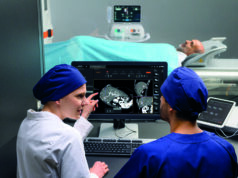
The US FDA’s granting of an investigational device exemption (IDE) allows MagForce to conduct a pivotal clinical evaluating the company’s NanoTherm therapy for intermediate risk stage patients at selected medical centres in the USA.
The purpose of this focal thermal ablation registration study that will enroll up to 120 men in a single arm study is to demonstrate that NanoTherm can focally ablate cancer lesions for patients who have advanced to intermediate risk prostate cancer stage and are under active surveillance. By focally ablating these cancer lesions, it is anticipated that patients will be able to be maintained in Active Surveillance Programs and to avoid definitive therapies such as surgery or whole gland radiation with their well-known side-effects.
In order to conduct the study, MagForce has already installed two NanoActivator devices, magnetic field applicators in which the NanoTherm therapy is performed, at University of Washington Medical Center in Seattle and at Christus Santa Rosa Hospital – Medical Center in San Antonio.
Ian M Thompson, Jr, president of Christus Santa Rosa Hospital – Medical Center and director, Cancer Therapy and Research Center, a National Cancer Institute-designated Cancer Center at the University of Texas Health Science Center at San Antonio, and Dan W Lin, chief of Urologic Oncology and professor in the Department of Urology at the University of Washington School of Medicine in Seattle, have agreed to be co-principal investigators in the focal thermal ablation registration study.
“We are delighted to announce that NanoTherm therapy has been granted FDA IDE approval. This is a significant milestone in the development of NanoTherm therapy for the treatment of prostate cancer patients in the USA and a significant step towards our goal—to supplement the current standard therapy with a less invasive, effective, and well-tolerated form of treatment. Potentially 50,000 to 100,000 men in active surveillance programmes in the US could benefit from this focal therapy after registration,” said Ben Lipps, chief executive officer of MagForce AG and MagForce USA.
NanoTherm therapy has obtained a CE mark in the European Union to treat brain tumours and is already commercially available to brain tumour patients at renowned treatment centres in Germany.
Potential advantage of focal ablation
Prostate cancer is treatable, if detected early. Within the past two decades, Active Surveillance Programs have been developed in the USA to follow the slow growth of prostate cancer in order to avoid the side-effects of definitive therapy (radiation or surgery), for as long as possible. Currently, there are over 250 Active Surveillance Programs in the USA. Active Surveillance is the merging of watchful waiting and active management into a program that is interactive for the patient, ultimately allowing a man diagnosed with prostate cancer to monitor his disease and have the highest quality of life possible while delaying or even completely avoiding invasive treatments.
For the past decade, these Active Surveillance Programs have been seeking a focal therapy which would ablate the small tumours that have progressed to the intermediate risk stage because approximately 60% of the patients in Active Surveillance Programs who have participated in these programmes for an extended period of time require definitive therapy such as whole gland surgery or radiation.
NanoTherm therapy represents a new concept for interstitial hyperthermia of the prostate. This method is based on the controlled transfer of energy from an alternating magnetic field to biocompatible, superparamagnetic nanoparticles injected into the tumour. The resulting amount of heat generated is suitable to directly destroy cancer cells. MagForce expects to ablate these small lesions of cancer with focal NanoTherm therapy with minimal adverse effects. With successful NanoTherm treatment, it is anticipated that the patients can return to Active Surveillance and keep their quality of life.













